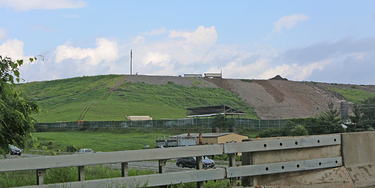State aims to reduce waste 85 percent through ‘circular economy’
ALBANY COUNTY — To combat greenhouse-gas emissions, New York state is aiming to severely reduce the amount of waste generated within its borders by 2050.
Its vision for this is laid out in the New York State Department of Environmental Conservation’s draft Solid Waste Management Plan, which emerged from its public comment period at the end of June.
According to the draft, waste accounts for 12 percent of the state’s greenhouse-gas emissions, making it the fourth largest sector, behind buildings at 32 percent, transportation at 28 percent, and electricity at 13 percent but ahead of industry at 9 percent.
In 2018, individual New Yorkers sent an average of more than four pounds of waste per day to disposal facilities, or three-quarters of a ton per year, the plan says. The goal is to reduce per capita disposal to just 0.72 pounds within the next 27 years.
The draft plan says that, to achieve this, the state will need to devise a “circular economy,” where waste is not “wasted” through disposal in landfills or other facilities, but recycled and prioritized over limited natural resources.
It’s a tall order given the increasing inclination toward “convenience culture,” which values single-use or short-use products — such as take-out food or fast fashion — in pursuit of a lifestyle that’s more individually convenient. But the state says it’s a necessary challenge given the existential threat of climate change.
“[The plan] is bold and should be bold if New York State is to achieve the transformational changes that are needed to address the global concerns today,” the draft states. “Small improvements are no longer sufficient to make the strides necessary to protect the environment.”
More locally and in the near-term, waste-reduction measures will also benefit the municipalities that rely on Albany’s Rapp Road Landfill, which is currently expected to close in May 2028 because it will have reached its capacity by then.
An earlier projection of 2026 was pushed back because waste there is not being deposited as quickly as it’s settling, according to minutes from a July 10 meeting of the Albany Common Council General Services Committee.
Even more time may be acquired if efforts to continue reducing and recycling waste are successful, City of Albany General Services Commissioner Sergio Panunzio told the committee.
All the municipalities in the Enterprise coverage area, and several others nearby that use the landfill, will need to find some other means of managing their waste, whether it be through whatever alternative the city comes up with or one derived on their own.
According to the minutes, the city does not take in enough waste for any other option beyond a transfer station, which DGS Deputy Commissioner Frank Zeoli said would likely increase the city’s trash fees.
State of waste
The types of waste in New York State are municipal solid waste, construction and demolition debris, non-hazardous industrial waste, and biosolids, all of which come together to create what’s known as the total waste stream.
In 2018, only 43 percent of the total waste stream was recycled, according to the draft; the rest was either put in a landfill (32 percent), shipped out of state (17 percent), or incinerated (8 percent).
Municipal waste, which is the second-largest category of waste at 45 percent of the total stream, was consistently recycled at the lowest rate between 2010 and 2018, a chart included in the draft indicates. This is followed by biosolids, industrial waste, and construction debris.
While municipal solid waste is recycled at a rate of just 19 percent, it’s made up largely of materials that are — at least in theory — recyclable or compostable.
According to the plan, paper makes up the largest portion of municipal waste at 32.1 percent, followed by food scraps at 16.6 percent, and plastics at 13.9 percent. An additional 26 percent is made up by yard trimmings, metals, textiles, glass, and wood, with the remaining 10 percent is composed of “miscellaneous” materials.
To be recycled, material must be of a certain condition, and without contamination from non-recyclable material, the draft says.
It mentions that in 2018, China, which received a large amount of recyclables from the United States and other countries, had imposed restrictions after discovering that too much of the material it was getting was unusable, substantially disrupting the recyclables market.
Construction debris, making up 46 percent of the waste stream, is recycled at a rate of 64 percent and is made up in large part by lithics like concrete and brick, soil and gravel, and wood, the plan says.
The DEC attributes the high recycling rate to regulations and enforcement, along with improved data collection. It notes that the rate is expected to keep going up over time.
Biosolids, which is the solid waste pulled from the wastewater treatment process, have the second-lowest recycling rate at 22 percent, falling from 47 percent in 2008. Biosolids make up just 4 percent of the total waste stream.
As The Enterprise previously reported, the Sierra Club and various activists have called attention to the DEC’s proposal to increase the amount of biosolids that are used on farmland as a fertilizer, arguing that fertilizer made up of toxic chemicals can harm people and the environment.
The DEC has proposed a draft policy — for which public comment ended on July 10 – that addresses biosolid use and includes sampling requirements and the ability of the DEC to prohibit recycling until a facility demonstrates that its levels of toxic chemicals are below the thresholds, according to a presentation on the law published by the DEC.
The final category of waste, industrial, makes up 5 percent of the total waste stream and is believed to be recycled at a rate of around 29 percent, though the draft plan notes that it is “challenging” to get accurate data for industrial waste because some waste transfer occurs outside of publicly monitored systems.
“A significant portion of the case-specific Beneficial Use Determination (BUD) program allows for the use of some waste as by-products to substitute for raw materials or commercial products,” the draft states. “These are often components of the industrial waste stream. Beneficial use is not always considered to be recycling, but it is a preferable alternative to waste disposal or combustion.”
In general, the DEC believes that at least 80 percent of all material “currently sent to landfills or for combustion still has monetary value either directly as material that could be used to produce goods or other beneficial uses or indirectly through the creation of recycling sector jobs,” according to the draft.
“Often,” it says, “the demand for these materials is misaligned within the supply chain, meaning that the supply is not readily available in the quality, condition, and location where and when it is demanded.”
Waste causes problems for the environment beyond its greenhouse-gas emission.
Plastics in the water can hurt wildlife, the overreliance on natural resources can destroy habitats, and, as mentioned, chemical infiltration of the environment can hurt people.
Initiatives
To tackle the problem of waste, the DEC has devised six focus areas, each made up of various goals, with action items for each goal, for a total of 168 specific recommendations, the draft says.
The six focus areas are:
— Waste prevention, reduction, and reuse;
— Recycling and recycling market development and resiliency;
— Design and operation of solid waste management facilities;
— Toxics reduction in products;
— Product stewardship and extended producer responsibility; and
— Organics reduction and recycling.
For waste prevention, the draft plan is calling primarily on the DEC itself to implement things like support for colleges and universities that are trying to reuse materials; to encourage materials exchanges; and to improve education around waste reduction, among others.
It calls on the state legislature to find ways to encourage consumers to choose repair over disposal of items; restrict single-use products; and ban the disposal of unsold retail items.
To improve the recycling market, the draft recommends that the DEC again focus on partnerships and education around various items, as it does for all the other focus areas.
Of the legislature, it asks for a disposal disincentive surcharge, legislation that reduces Returnable Container Act fraud, and support for the development of recycling facilities, among several other things.
It also calls on the GreenNY Council to improve the amount of recyclable materials purchased by state agencies and ensure that the material is properly recycled.
Product stewardship involves making sure that companies are responsible for the products they create, so the draft calls on, for instance, the Department of Health to streamline the pharmaceutical take-back program, and the legislature to pass laws related to e-waste, batteries, and materials that contribute substantially to greenhouse gas emissions.
Organics reduction is largely in the domain of the DEC, which is asked to financially support food banks and other organizations that promote food donation, as well as to promote municipal food-scraps collections programs and things like farmers’ markets and community gardens; as well as to expand partnerships and education.
For toxics reduction, the draft asks the DEC to develop regulations around the disclosure of product ingredients and the testing of chemicals. It calls on the Office of General Services to restrict the presence of toxic materials in products purchased by the state, and the legislature to ban materials and chemicals that are of growing concern.
To improve the design and operation of solid-waste management facilities, the DEC is asked to amend current regulations so that they are in line with legislative changes, community feedback, and ecological needs. It’s also asked to improve data collection, among many other things.
The legislature is tasked with helping to fund landfill-closure and gas-management projects, and imposing requirements on municipalities to create solid-waste management plans or to partner with municipalities that have them in place, along with funding that helps mitigate the impact of waste sites on drinking water.
All 168 action items listed are expected to be initiated during the document’s planning period, which extends from 2023 to 2032.
“Many of the Action Items require both an action, such as a piece of legislation, but also robust implementation of an ongoing program that will have impacts beyond 2032 and 2050 …,” the draft states. “By the end of 2032, it is projected that the recycling rate for the total waste stream will be 60%, and it will increase to 85% by the end of 2050.”



